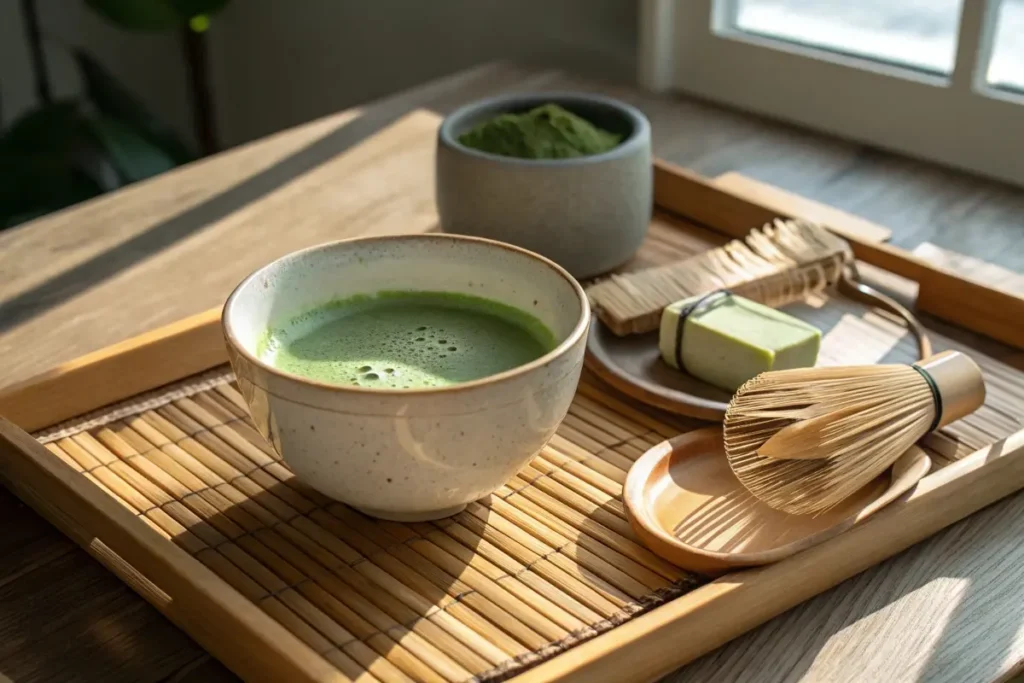Enjoying matcha is more than just drinking tea—it’s an immersive experience that honors centuries of Japanese tradition. At the heart of it all stands the ceramic matcha bowl, also known as a chawan. Crafted to whisk, hold, and showcase vibrant green matcha, these bowls merge artistry and function in one carefully designed piece of pottery. In the first few sips, you’ll notice how the bowl’s structure influences the tea’s texture, temperature, and overall character. Whether you’re a casual tea lover or an avid collector of traditional teaware, exploring the nuances of a ceramic matcha bowl can deepen your appreciation for this ancient beverage.
Ceramic matcha bowls come in an array of styles—ranging from Handmade ceramic matcha bowl designs with rustic glazes, to sleek modern variations like a Ceramic Matcha Bowl with Spout. Each appeals to different aesthetics and brewing preferences. But they all share a singular purpose: to enhance every aspect of making and savoring matcha. With matcha’s global rise in popularity, many enthusiasts now realize that an ordinary mug doesn’t quite deliver the same delicate froth or concentrated aroma. By choosing a specialized bowl, you’re embracing an integral part of tea ceremony culture, while also perfecting your at-home brewing technique. If you’re curious about pairing your tea ritual with Japanese-inspired meals, consider visiting our Traditional Japanese Desserts Recipe for sweet treats that complement the earthy richness of matcha.
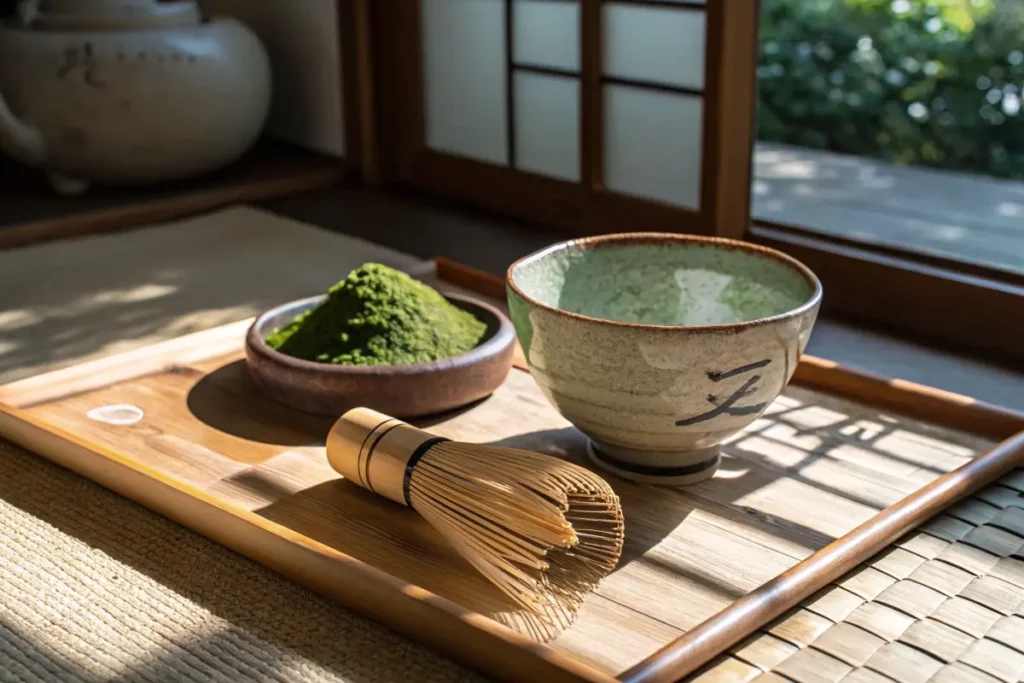
Table of Contents
Understanding the Ceramic Matcha Bowl
Function and Design
A ceramic matcha bowl—often referred to as a chawan—serves a precise purpose: to help whisk matcha into a foamy, velvety texture. Its broad mouth is essential for the whisking motion, allowing you to incorporate air swiftly. The depth helps retain warmth, so each sip remains pleasantly temperate without scorching your hands. Many appreciate that slight slope around the inside, which ensures matcha powder and water blend evenly.
Materials and Craftsmanship
Ceramic matcha bowls can be fashioned from various clays—earthenware, stoneware, or porcelain. Artisans might prefer earthenware for a more rustic appeal, or porcelain for a sleek, modern feel. Meanwhile, glazes can be matte, glossy, or anywhere in between. Some bowls might have a raku-style glaze—a historical method famed for its unpredictably beautiful, crackled surfaces. Others may be as straightforward as a uniform color like black, white, or earthy brown. Regardless of the finish, each design choice aims to accentuate matcha’s vibrant hue and enhance the overall tea experience.
Shape Variations
- Classic Cylindrical: Straight or slightly flared sides. Ideal for whisking vigorously without spilling.
- Wide & Shallow: Known in some schools of tea ceremony for summer use, encouraging quick cooling.
- Narrow & Tall: Suited for winter, conserving heat for longer sessions.
- Ceramic Matcha Bowl with Spout: A modern adaptation featuring a small lip, easing the transfer of whipped tea if needed, or for precise pouring during culinary use.
Each shape influences how you whisk and serve the tea. For instance, a wide, shallow bowl showcases the luscious froth, while a deeper bowl might hold heat more effectively. If you’re aiming to create matcha-laden recipes, a bowl with a gentle spout or angled rim can be a practical companion.
Aesthetic and Cultural Value
Beyond function, a ceramic matcha bowl also speaks to a storied aesthetic. Traditional Japanese tea ceremonies emphasize wabi-sabi, finding beauty in imperfection and transience. Subtle glaze drips or slight asymmetry can add character and a feeling of authenticity. Handmade ceramic matcha bowl sets often carry a personal touch—each bowl might display unique textures shaped by the potter’s hands.
Why Not Just Any Bowl?
One might ask, “Why invest in a specialized ceramic matcha bowl?” Start with the fundamental differences: standard kitchenware might be too tall, narrow, or lacking in thermal retention. Without the right curvature, whisking can become messy or incomplete. Moreover, you may not achieve the ideal froth that’s central to a silky, satisfying matcha. In short, a purpose-built ceramic matcha bowl fosters the best environment for whisking matcha to a perfect head of foam. If you want to experiment with a broader range of Japanese cooking, check out our Japanese Chicken Curry Recipe for a hearty main course to balance the delicacy of your tea break.
Beyond Matcha
While the primary function remains whisking green tea, some owners use their bowls for other tasks, like mixing small amounts of sauce or whisking eggs for a quick marinade. That said, these bowls are best preserved for matcha or other tea-based usage. Over time, slight surface changes can occur, forming a personalized patina that many view as an evolving art piece—a reflection of daily tea rituals.
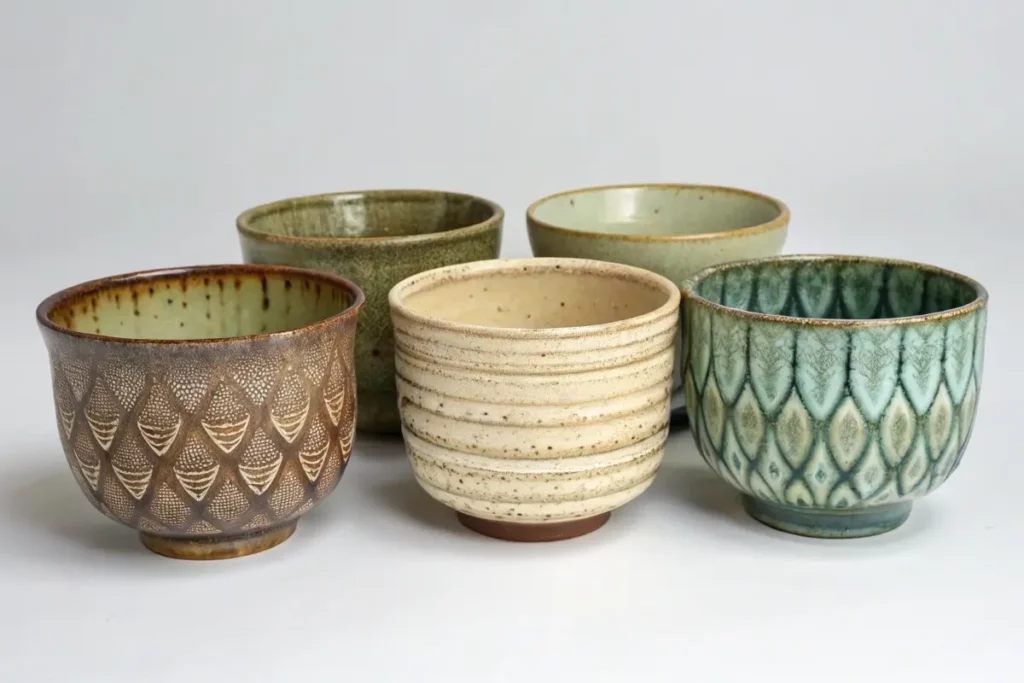
Choosing the Right Ceramic Matcha Bowl
Identifying Your Purpose
Consider your primary goal. Are you an avid tea ceremony practitioner seeking authenticity? Or do you want a convenient way to make matcha at home? Beginners might appreciate a more standard cylindrical bowl, while experts might look for specialized forms aligned with specific tea ceremony schools.
Types of Clay and Glaze
- Stoneware: Fired at higher temperatures, typically robust and chip-resistant. Favored for everyday usage.
- Earthenware: Porous and might require special care. Known for a rustic look, often used in raku pieces.
- Porcelain: Glossy, sometimes delicate. Great for a refined, modern aesthetic.
A handcrafted, Handmade ceramic matcha bowl often features subtle variations that speak to the potter’s technique. Conversely, mass-produced items offer consistent design and often come in “matcha bowl and whisk” sets. Both have their merits—one is unique and artisanal, while the other might be more budget-friendly and widely available.
Size and Dimensions
Aim for a diameter of around 4.5 to 5 inches. This space accommodates the whisking motion. Depth can vary from 2 to 3.5 inches or so. Big enough to swirl the whisk with minimal spillage, yet compact enough to cradle comfortably in your hands. If you’re someone who loves multiple small cups in a single session, a shallower, wide-lipped bowl might be best for quick cooling. Or, if you prefer lingering over your tea, a deeper design is beneficial.
Understanding Seasonality
Traditional tea ceremony “schools” use different bowl shapes for different times of year.
- Summer: A wide shape for faster cooling.
- Winter: A narrower profile for retaining heat.
Though modern matcha drinkers often skip such formalities, it can be pleasant to align your bowl choice with the seasons for a more classical feel.
Quality Indicators
- Smooth Interiors: Minimizes lumps by preventing matcha from getting trapped in grooves.
- Solid Base: Provides stability when whisking.
- Comfortable Weight: A bowl that’s too heavy or too light may hinder your whisking.
- Glaze Durability: A stable, food-safe glaze that won’t chip or react with hot liquids.
A Note on Spouts
The Ceramic Matcha Bowl with Spout suits those who like to pour matcha—maybe into smaller cups or for cooking. This design helps prevent messy dribbles. Chef enthusiasts might love it for whisking matcha-based sauces or dressings before neatly pouring onto plates. If you want to get creative with matcha cooking, see our Japanese Vegan Recipes for plant-based dishes that pair well with bright green tea flavors.
The Decorative Factor
Beyond function, ceramic matcha bowls also double as decorative elements. Some tea lovers keep them displayed on shelves, highlighting their craftsmanship. Brightly colored glazes contrast nicely with matcha’s green foam, while subdued earthy tones exude subtle elegance. Patterns like floral motifs or bold calligraphy add cultural flair, turning each tea session into an artful event. Remember, best ceramic matcha bowl set reviews often emphasize visual allure almost as much as whisking performance.
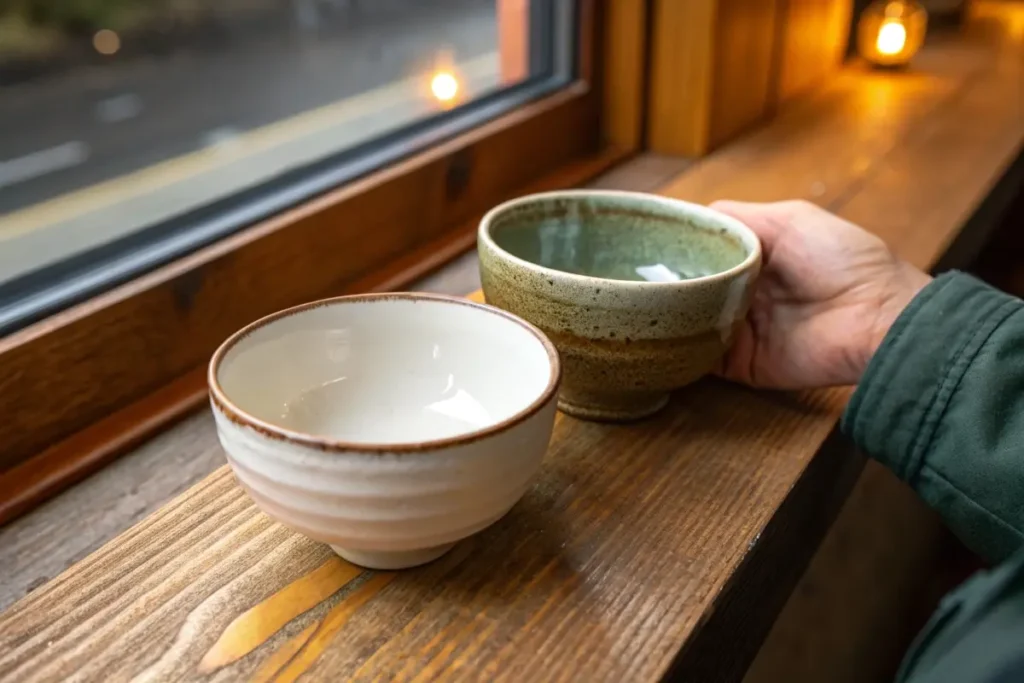
Caring for Your Ceramic Matcha Bowl
Initial Use and Seasoning
Unlike cast iron or clay pots that require “seasoning,” ceramic matcha bowls don’t typically need elaborate preparation. However, some tea aficionados recommend rinsing the bowl gently with warm water upon purchase. This ensures any residual dust or kiln debris is removed. Doing this also helps you familiarize yourself with the bowl’s feel—an important aspect of tea ceremony mindfulness.
Cleaning Techniques
- Gentle Wash: Handwash with mild soap or just warm water. Avoid harsh detergents that may leave residues affecting taste.
- No Soaking: Extended soaking can weaken certain glazes, especially with earthenware. A quick rinse usually suffices.
- Avoid Abrasives: Steel wool or harsh scrubbers might scratch glazes. A soft cloth or sponge is best.
If you see matcha stains over time, they are generally a non-issue. Many consider subtle staining as part of the bowl’s patina, reflecting repeated tea experiences. For a deeper clean, swirl warm water with a small amount of mild dish soap gently, then rinse thoroughly.
Storage
Store your ceramic matcha bowl in a dry place, away from direct sunlight. Extreme temperature fluctuations—like placing it right next to a stove or heater—might stress the ceramic. Some prefer to keep matcha bowls on a display shelf, not only for convenience but also to showcase their artistry. If you use multiple bowls for different ceremonies or seasons, rotating them occasionally helps distribute wear evenly.
Handling Tips
Ceramic matcha bowls can be fragile, especially if made with a delicate clay body or refined porcelain. Even sturdy stoneware can crack if dropped on hard surfaces. Carefully hold your bowl by the sides or base when whisking. If traveling with your bowl—maybe for a demonstration or a social tea gathering—pack it securely with soft padding, such as bubble wrap or a cloth pouch.
Avoiding Thermal Shock
Pouring boiling water straight from a kettle into a cold bowl could cause micro-cracks, known as thermal shock. To prevent this, you can warm your bowl with a small amount of hot (not boiling) water first. That way, the material gently adjusts to higher temperatures. This step also readies the bowl for whisking, ensuring the final brew stays warm longer.
Long-Term Maintenance
If your bowl develops tiny cracks in the glaze over time, it might be a kintsugi candidate. This Japanese art of repairing ceramics with lacquer mixed with gold or silver dust transforms a flaw into a highlight. While not strictly necessary, some collectors enjoy this practice to celebrate the piece’s journey. If you’re more comfortable with simpler fixes, an invisible epoxy repair can keep your bowl functional.
Using Additional Accessories
Proper care extends beyond the bowl itself. A matcha whisk (chasen), bamboo scoop (chashaku), and whisk holder all play roles in maintaining a cohesive tea station. Minimizing direct contact between a wet whisk and the bowl’s bottom also reduces scratching. If you’re diving deeper into matcha tea accessories, you’ll find sets that provide bowls, whisks, and more, making the entire process seamless. For a deeper exploration of Japanese culinary gear, you might enjoy the curated insights in our Discover Japanese Recipes page.
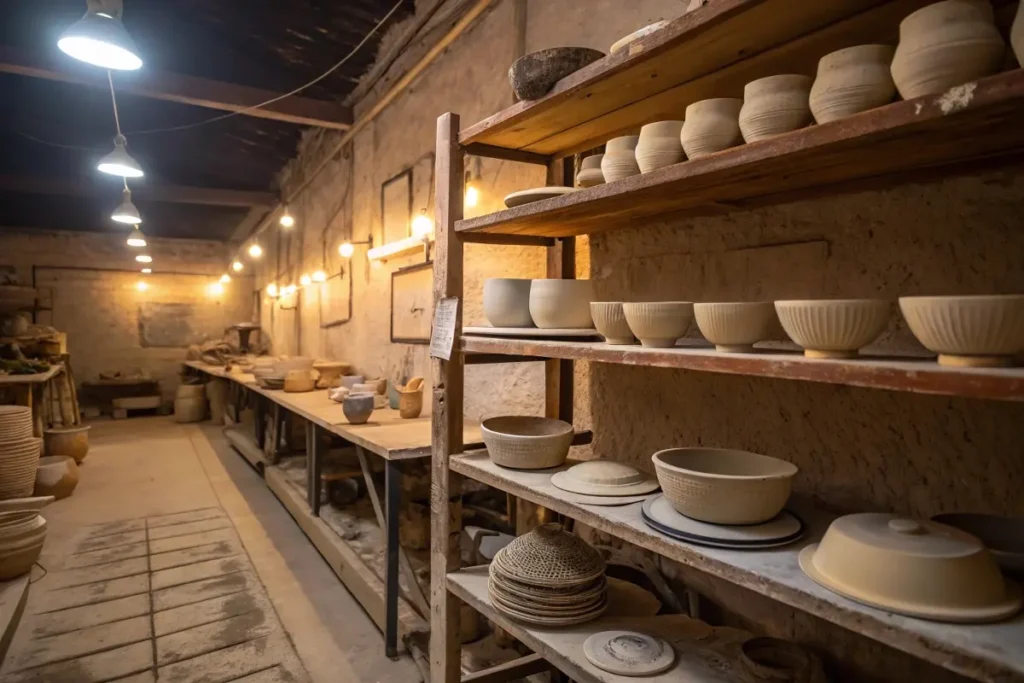
History and Context
Early Tea Culture
Green tea found its way to Japan from China during the 9th century, primarily enjoyed by monks and elites. Over subsequent centuries, chanoyu (the tea ceremony) evolved under Zen Buddhist influences, emphasizing ritual, simplicity, and a close connection to nature. This formalization demanded specialized tools: from tea canisters to whisks, each component gained cultural significance. Bowls, in particular, became a focal point—holding both aesthetic and spiritual weight.
Emergence of Ceramic Matcha Bowls
Around the 14th to 16th centuries, local potters began crafting bowls specifically for tea whisking. They drew on Chinese precedents but gradually developed distinctive Japanese styles. Certain historic kilns—like those in Seto, Mino, and later Raku—became renowned for tea bowl production. Artisans used locally available clay, shaping each piece by hand or wheel, then finishing them with region-specific glazes. Over time, these bowls not only varied by region but also by the preferences of influential tea masters like Sen no Rikyu, who championed simplicity and the concept of wabi-sabi.
Influence of Zen and Aesthetics
Zen philosophy imbued the tea ceremony with deep meditative underpinnings. The ceremony’s measured, reflective steps mirrored life’s cyclical nature. This approach also guided the appearance of matcha bowls—unassuming forms, subtle glazes, sometimes intentionally flawed to celebrate impermanence. Such an ethos contrasted with the era’s lavish decorations, marking these bowls as icons of humble elegance.
Spread Beyond Japan
From the 19th century onward, as global trade expanded, collectors and connoisseurs outside Japan discovered these handcrafted bowls. Eventually, ceramic matcha bowl sets gained traction internationally—particularly when matcha began surging in popularity for its health benefits and rich flavor. Western potters tried replicating the style, bridging Eastern and Western ceramic traditions. The modern quest for “authentic” or handmade ceramic matcha bowl forms led to a renewed appreciation for historical kilns and storied lineages of pottery families in Japan.
Present Day Significance
Today’s global tea culture highlights matcha as a wellness beverage, attracting a wide audience. While some enjoy matcha purely for nutritional perks, others delve deeper into ceremonial roots. The ceramic matcha bowl stands at that intersection, symbolizing both tradition and contemporary usage. Many artisans continue to innovate, adding personal touches—like spouts or bold glazes—while still respecting the classic shapes from centuries ago. This continuity between past and present ensures that each bowl remains a living piece of cultural heritage.
If you find yourself drawn to the historical artistry behind everyday Japanese cookware, you might also appreciate Hot White Japanese Food references, showcasing how traditional techniques carry forward into modern culinary contexts.
Practical Examples/Use Cases
1. Traditional Tea Ceremony at Home
Setting up a personal matcha ritual can be as simple or elaborate as you desire. Lay out your ceramic matcha bowl, whisk (chasen), bamboo scoop (chashaku), and a small tea caddy. Warm the bowl with hot water, discard it, then sift your matcha into the bowl. Gradually add hot (but not boiling) water—around 70–80 °C—and whisk in W-shaped motions until a creamy foam emerges. Enjoy the quiet moment, sipping from the same side the whisk entered. This mindful practice, even if brief, replicates the reverent atmosphere of a formal tea ceremony.
2. Culinary Adventures
Beyond the ceremonial aspect, your ceramic matcha bowl can aid in creating matcha-flavored desserts or drinks. Mix matcha with a bit of water until it’s lump-free, then combine it with sweeteners or milk for lattes, or swirl it into dough for vibrant green cookies. The bowl’s interior shape helps blend the powder thoroughly, preventing lumps that might affect taste or color. If you’re craving more creative matcha ideas, explore Japanese Dessert Recipes to find treats that highlight matcha’s sweet-earthy flavor.
3. Hosting a Matcha Session
Inviting friends to share matcha fosters community. Each person can whisk their own portion or watch you demonstrate. Place multiple bowls around the table if you own a Japanese ceramic matcha bowl set. Everyone can appreciate subtle differences in glaze or shape. This interactive approach also suits mini-tastings: let guests compare a “summer” style wide bowl versus a “winter” style deeper bowl, noting how each affects mouthfeel.
4. Display and Collecting
Ceramic matcha bowls can double as décor items, displayed on shelves or sideboards. They reflect personal style, cultural interest, and artistry. Some collectors rotate bowls seasonally or arrange them by glaze color for an eye-catching gradient. If you own a best ceramic matcha bowl set, featuring consistent designs across multiple pieces, the uniform aesthetic can unify your living space. Still, these bowls remain functional art—always ready to serve a comforting brew.
5. Improvised Use
In a pinch, a matcha bowl might step in for tasks like whisking a single egg or stirring a small portion of sauce. While purists might prefer preserving the bowl exclusively for tea, day-to-day home cooks occasionally utilize it as a handy mixing dish. The important note is not to apply anything that might permanently flavor or scratch the glaze. As long as you’re gentle, the bowl remains a flexible kitchen companion.
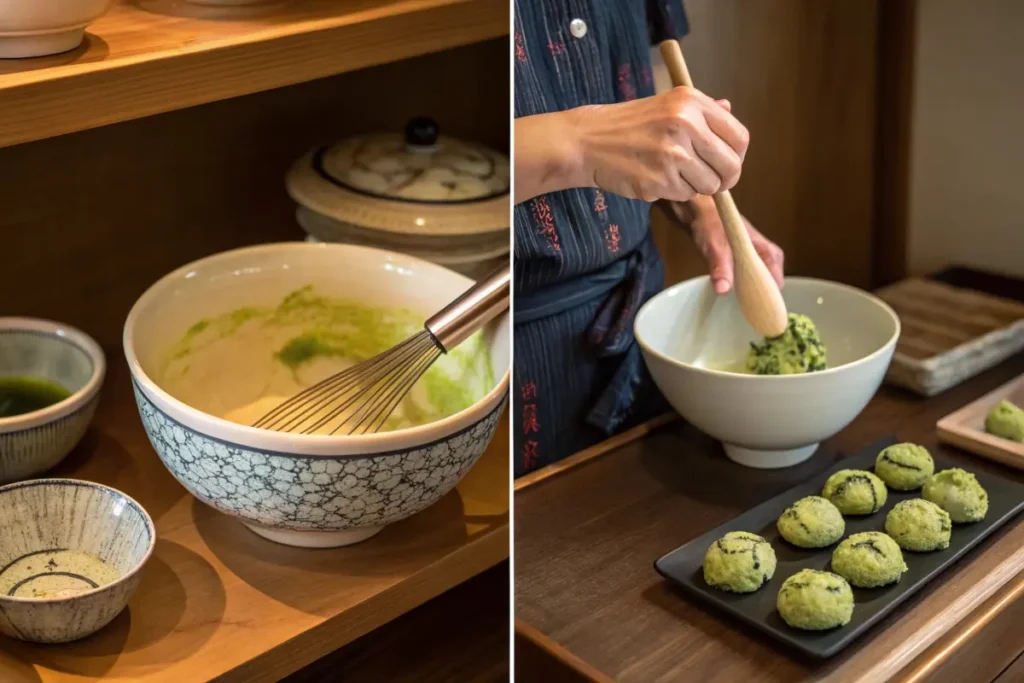
FAQs
1. What size is a large ramen bowl, and is it similar to a matcha bowl?
Ramen bowls typically have wider diameters (often 7–9 inches) and deeper sides. They’re designed to hold broth, noodles, and toppings. A ceramic matcha bowl, on the other hand, is generally smaller—around 4–5 inches wide—optimizing whisking space without excessive depth. While both are Japanese ceramics, they serve different functions.
2. What is the difference between a matcha bowl and a pho bowl?
A matcha bowl focuses on whisking efficiency and comfortable handholding. Pho bowls hold large amounts of liquid, noodles, and garnishes. The shapes differ significantly—pho bowls are typically broader and can be quite deep. Meanwhile, a matcha bowl’s form specifically helps create foam from finely ground green tea.
3. What is the Korean ramen bowl called?
In Korean cuisine, you might find stainless steel or stone bowls for instant ramen, often referred to more generally as “ramen pots” or “ddeokbaegi” (for soups). They differ from Japanese ceramic matcha bowls in design, function, and cultural context. Korean bowls often handle high heat well, especially for boiling on stovetops.
4. How big is a 1000 ml bowl relative to matcha bowls?
A 1000 ml capacity bowl can be quite large—holding roughly four times more liquid than a typical matcha bowl. Most ceramic matcha bowl sizes hover around 250–400 ml capacity, prioritizing easy whisking. A 1000 ml bowl might be overkill for daily matcha sessions, but it’s not unheard of in specialized tearooms or if you plan to prepare multiple servings at once.
5. Can I use a ceramic matcha bowl set for everyday tea or only for ceremonies?
Absolutely, you can use it daily. The idea that matcha bowls are “only for ceremonies” is more tradition than rule. Many modern tea enthusiasts brew daily matcha for health benefits or taste pleasure in these specialized bowls—no formal ceremony required.
6. Are handmade ceramic matcha bowls dishwasher safe?
While some are robust enough for dishwashers, it’s safest to handwash them. The high heat and abrasive detergents in dishwashers might degrade delicate glazes over time. Always check the potter’s or manufacturer’s guidelines to confirm.
7. Do I need a whisk for using a ceramic matcha bowl?
Yes. The chasen—a bamboo whisk—plays a pivotal role in whisking matcha to a frothy layer. Without it, lumps or uneven texture could remain. If you’re assembling a complete matcha set, consider the “matcha green tea whisk and bowl” combo for best results.
Conclusion
A ceramic matcha bowl is far more than a simple container—it’s a gateway to an immersive tea experience that merges craftsmanship, tradition, and personal ritual. From its shape and glazing to the technique of whisking, every element draws you deeper into Japanese tea culture, encouraging a mindful pause in your day. Whether you’re practicing an elaborate chanoyu-style ceremony or simply whisking a morning cup of matcha for a caffeine boost, the right bowl can enrich your enjoyment immeasurably.
Maintaining a ceramic bowl also fosters a sense of stewardship for your tea tools. Over time, each whisking session leaves subtle marks that echo your daily ritual, turning the bowl into a cherished object that grows more meaningful with use. And if your passion expands beyond the tea realm, you might find synergy in pairing your drinks with simple Japanese meals or desserts, as illustrated in our curated Japanese Recipes. Ultimately, selecting a shape, glaze, and style that resonates with you ensures your bowl becomes a daily companion—helping you discover the meditative calm, the rich flavors, and the joyful simplicity that matcha can bring to life.
